| Notes:
The Halesowen & Bromsgrove Branch Railway (H&BBR) was incorporated on 5 July 1865 to construct a 6-mile line from Halesowen Junction on the Midland Railway (MR) Bristol & Gloucester route to form an end-on connection with the Great Western Railway (GWR) Halesowen Branch. A second branch was also authorised to make another connection with the MR near Longbridge, likewise on the Birmingham to Gloucester line. By 1870 the company had run into financial difficulties so, realising that the plans were too ambitious, an application was made to Parliament for the connection with the Midland at Bromsgrove to be abandoned; this was authorised on 1 August 1870. Building of the line had yet to begin as the H&BBR was unable to find a contractor willing to take on the financial burden of construction. On 13 July 1876 the H&BBR assumed the title of the Halesowen Railway (HR) and construction of the first section of the line began. Prior to this, on 30 July 1872 a working agreement was drawn up between the HR, GWR and MR for the two companies to operate the line jointly and for the HR to construct a station on the MR at Northfield. The completed line was inspected by the Board of Trade in August 1881 and was found to be unsatisfactory; following modifications it was passed for use in May 1882. Sadly the line did not open immediately as a dispute between the HR and the MR developed owing to the former not completing building work at the station at Northfield, as was part of the working agreement. With the dispute settled the line finally opened on 10 September 1883, over a year since it was passed for use. A celebratory public breakfast was held at the Shenstone Hotel on 1 October 1883. The GWR and MR operated the line for 50% of gross receipts for the next 20 years but by the early 1900s the HR was in financial difficulty. In 1904 the HR was declared bankrupt, and following this the company was jointly vested in the GWR and MR on 1 July 1906.
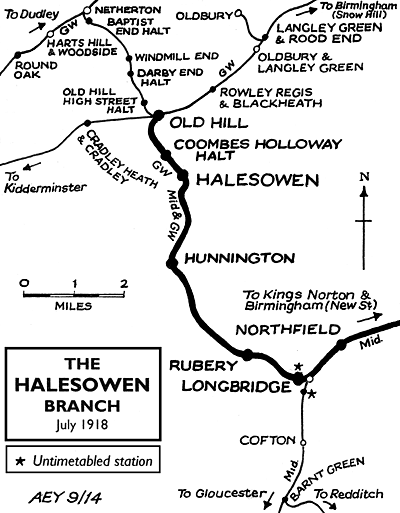 The station at Rubery opened on 10 September 1883 and was constructed in a distinctly MR style which were located on the down, Halesowen direction, platform. The main building was brick-built and combined the stationmaster’s house with the offices and public facilities. The two-storey house with a pitched roof was aligned at right angles to the platform and lacked adornment, its two chimneystacks being the most prominent feature. The hipped-roofed, single-storey office and waiting room range adjoined the house. The public entrance and booking hall stood forward, adjacent to the station house, but the platform frontage was straight. Whilst the window openings of the house were rectangular, some of those on the other section were of the ‘Board School’ style with shallow segmental arches. A flat-roofed toilet and store block adjoined the office range. The up platform was a basic affair with what appears from old maps to be a waiting shelter. There also seems not to have been a footbridge provided at the station with passengers probably having to cross the line via a barrow crossing. The main purpose of the station having two platforms was to provide a passing loop midway along the branch and run-round facilities for the early passenger service, although the sparse traffic probably never warranted it. A MR pattern signal box was provided at the Longbridge end of the down platform. The new service was advertised via handbills naming it as the ‘Halesowen and Northfield Railway’. Initially there were seven services in each direction on weekdays with no Sunday trains. Of these seven, three ran from Halesowen through to King Norton, three from Halesowen to Rubery, and one service ran through to Birmingham New Street; the same was true for trains operating in the opposite direction. By December 1895, Bradshaw shows that the Halesowen to Rubery service had been discontinued but the Halesowen to Kings Norton provision had increased to five services each way on weekdays; again there was no Sunday service. The station at Rubery opened on 10 September 1883 and was constructed in a distinctly MR style which were located on the down, Halesowen direction, platform. The main building was brick-built and combined the stationmaster’s house with the offices and public facilities. The two-storey house with a pitched roof was aligned at right angles to the platform and lacked adornment, its two chimneystacks being the most prominent feature. The hipped-roofed, single-storey office and waiting room range adjoined the house. The public entrance and booking hall stood forward, adjacent to the station house, but the platform frontage was straight. Whilst the window openings of the house were rectangular, some of those on the other section were of the ‘Board School’ style with shallow segmental arches. A flat-roofed toilet and store block adjoined the office range. The up platform was a basic affair with what appears from old maps to be a waiting shelter. There also seems not to have been a footbridge provided at the station with passengers probably having to cross the line via a barrow crossing. The main purpose of the station having two platforms was to provide a passing loop midway along the branch and run-round facilities for the early passenger service, although the sparse traffic probably never warranted it. A MR pattern signal box was provided at the Longbridge end of the down platform. The new service was advertised via handbills naming it as the ‘Halesowen and Northfield Railway’. Initially there were seven services in each direction on weekdays with no Sunday trains. Of these seven, three ran from Halesowen through to King Norton, three from Halesowen to Rubery, and one service ran through to Birmingham New Street; the same was true for trains operating in the opposite direction. By December 1895, Bradshaw shows that the Halesowen to Rubery service had been discontinued but the Halesowen to Kings Norton provision had increased to five services each way on weekdays; again there was no Sunday service.
 Bradshaw's of December 1895 shows the sparse service to and from Rubery Bradshaw's of December 1895 shows the sparse service to and from Rubery
The station was provided with a small goods yard to the east of the down platform which was entered via a trailing set of points immediately prior to the signal box. To the rear of the up platform there was an extensive set of sidings used in conjunction with the quarry which was situated directly north of the station and the construction of Birmingham Corporation Water Works at Frankley reservoir. The water works branch line was authorised in 1896 and named the ‘Rubery and Frankley Railway’ and it ran for a mile north of the station. It was essentially a contractor’s standard gauge line which, at its peak, employed six locomotives. With the completion of the reservoir in around 1905 the branch line closed but remained in situ until the outbreak of the First World War when it was lifted throughout. The sidings associated with it at the station continued to be used by the quarry until around the time of closure.
During the First World War Rubery played an important role acting as a reception point for ambulance trains conveying injured soldiers back from the Western Front. The casualties were then taken by road to Hollymoor and Rubery Hill hospitals.
In 1905 the Austin Motor Company opened a new car plant at Longbridge. By 1913 the workforce had grown to around 2,300 employees and by the end of the First World War it had swelled to 22,000. In 1915 the first sidings were laid at the plant and the MR and GWR obviously saw the increasing workforce as a chance to increase passenger revenue along the branch. A new station was constructed in the MR style. Even with the increase in use the general passenger 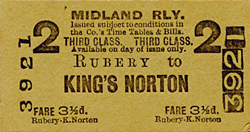 numbers never reached acceptable levels, and in April 1919 the MR withdrew the passenger service between Halesowen and Kings Norton. It was the GWR who introduced a daily workmen’s service each way between Old Hill and Longbridge. This unadvertised service called at Rubery and the date of the cessation of this stop is disputed with some sources quoting April 1934 as the final date whilst others give it as 29 August 1958. Photographic evidence shows that during the 1950s the weed infested down platform was cleared and gravel laid as the platform surface; this alone suggests that the workmen’s service was still making its daily stops. Although passenger services had been discontinued as early as 1919 the station was still staffed at least until the mid 1950s. Apart from the railtours, which became a feature of the line in its latter years of operation, the final documented working of a passenger train to and from Rubery was on 28 August 1960 when the Rubery Tenants’ Association ran a chartered excursion to Belle Vue, Manchester. numbers never reached acceptable levels, and in April 1919 the MR withdrew the passenger service between Halesowen and Kings Norton. It was the GWR who introduced a daily workmen’s service each way between Old Hill and Longbridge. This unadvertised service called at Rubery and the date of the cessation of this stop is disputed with some sources quoting April 1934 as the final date whilst others give it as 29 August 1958. Photographic evidence shows that during the 1950s the weed infested down platform was cleared and gravel laid as the platform surface; this alone suggests that the workmen’s service was still making its daily stops. Although passenger services had been discontinued as early as 1919 the station was still staffed at least until the mid 1950s. Apart from the railtours, which became a feature of the line in its latter years of operation, the final documented working of a passenger train to and from Rubery was on 28 August 1960 when the Rubery Tenants’ Association ran a chartered excursion to Belle Vue, Manchester.
When the railways were nationalised on 1 January 1948 the Halesowen Railway was allocated to British Railways (BR) Western Region, but in a boundary adjustment on 1 February 1958 it was transferred to London Midland Region administration. Private motor vehicle ownership rapidly expanded during the 1950s, and with demand for its train services declining BR announced that the workmen’s trains would be discontinued on 29 August 1958. Representations from Birmingham City Council over the issue of the withdrawal had a limited effect, with the Birmingham New Street to Longbridge being retained temporarily. So, on 29 August 1958, the final Longbridge to Old Hill service departed, with the Birmingham New Street services finally ending on 2 January 1960. The council placated inconvenienced passengers with the assurance that the ‘improvements in bus services adequate to cover the workers’ needs’.
The line north of Rubery to Halesowen was closed on 6 January 1964, the final train having run on 4 January. The Rubery to Longbridge section lasted only another six months, being closed on Monday 6 July 1964. The line to a point north of Longbridge station was lifted with what has been described as ‘indecent haste’. The station buildings and signal box were demolished sometime after February 1966, and the platforms were left for nature to take over until the early 1980s when the whole area was redeveloped as part of the Frankley Housing Project.
Tickets from Michael Stewart and route map by Alan Young.
Sources:
- Bradshaw's Railway Guide December 1895
- A Regional History of the Railways of Great Britain - Volume 7 The West Midlands - Rex Christiansen - David St John Thomas Publisher 1991
- A Century of Railways around Birmingham and the West Midlands - John Boynton - Mid England Books Publisher 1999
- Lost Lines Birmingham and the Black Country - Nigel Welbourn - Ian Allan Publishing 2002/2006
- Lost Railways of Birmingham & The West Midlands - Terry Moors - Countryside Books 2008
-
To see other stations an the Halesowen branch click on the station name:
Longbridge 2nd, Hunnington, Halesowen, Coombes Holloway Halt & Old Hill
See also:
Longbridge 1st & Longbridge 3rd
|

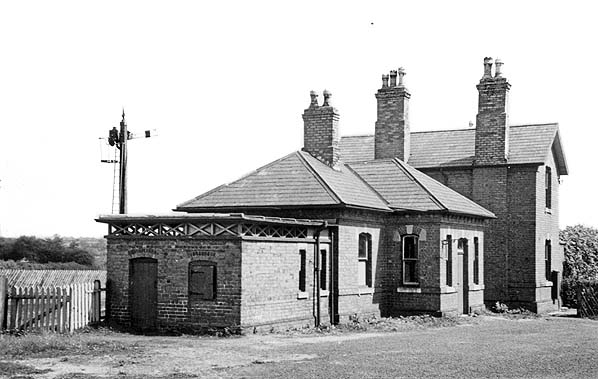
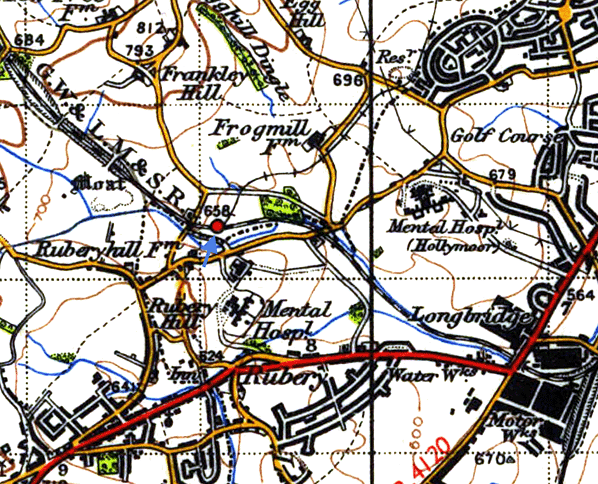
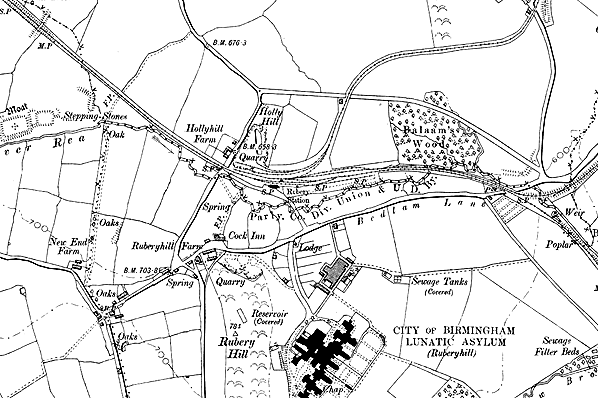
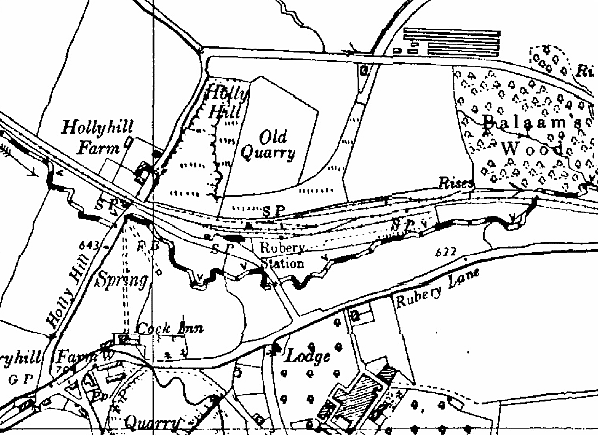
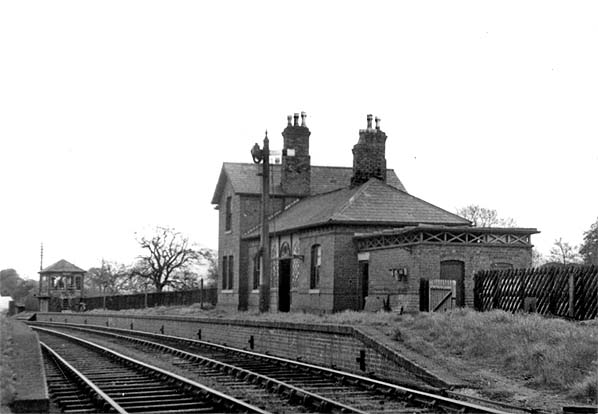
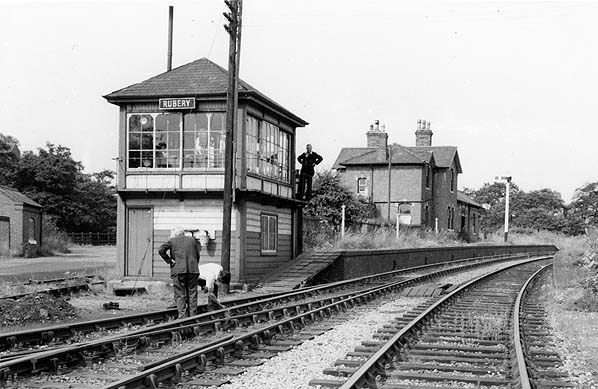
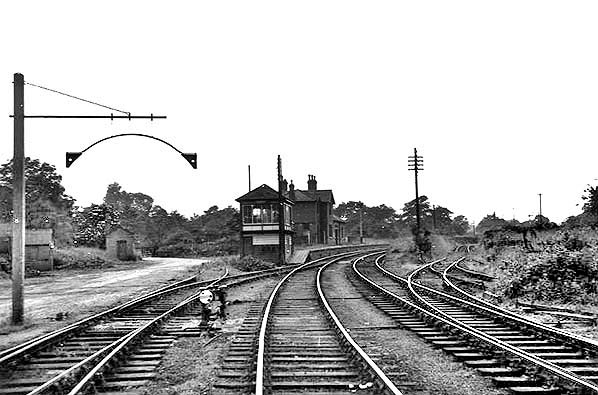
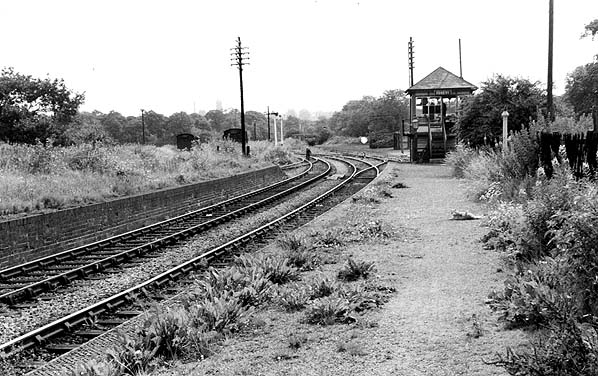
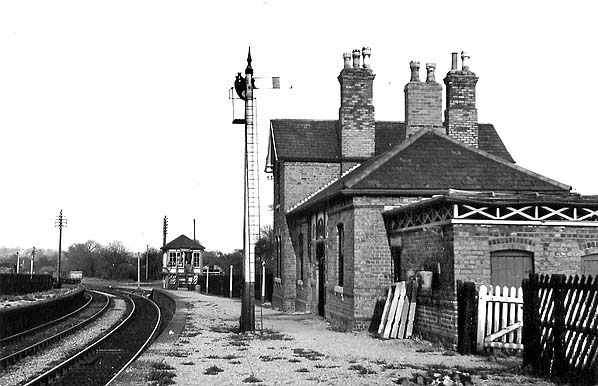
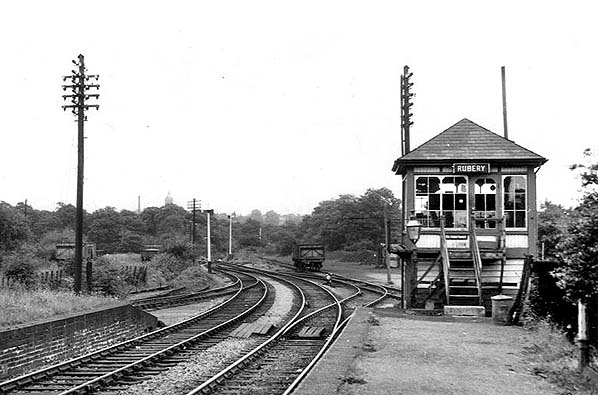
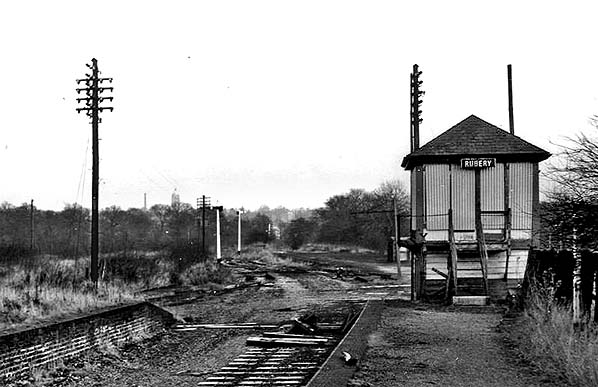
.jpg)
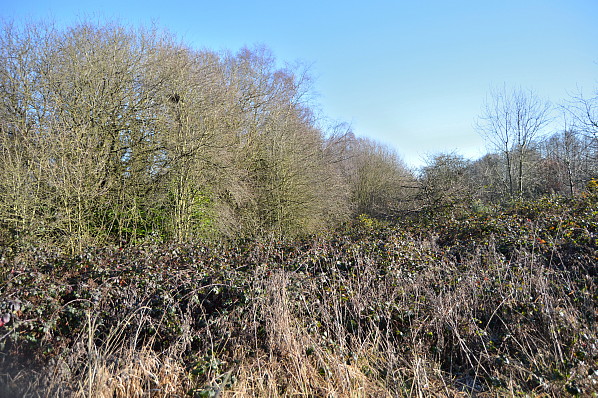
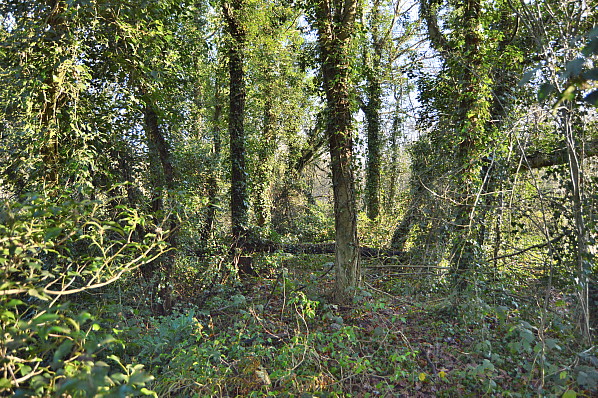
 The station at Rubery opened on 10 September 1883 and was constructed in a distinctly MR style which were located on the down, Halesowen direction, platform. The main building was brick-built and combined the stationmaster’s house with the offices and public facilities. The two-storey house with a pitched roof was aligned at right angles to the platform and lacked adornment, its two chimneystacks being the most prominent feature. The hipped-roofed, single-storey office and waiting room range adjoined the house. The public entrance and booking hall stood forward, adjacent to the station house, but the platform frontage was straight. Whilst the window openings of the house were rectangular, some of those on the other section were of the ‘Board School’ style with shallow segmental arches. A flat-roofed toilet and store block adjoined the office range. The up platform was a basic affair with what appears from old maps to be a waiting shelter. There also seems not to have been a footbridge provided at the station with passengers probably having to cross the line via a barrow crossing. The main purpose of the station having two platforms was to provide a passing loop midway along the branch and run-round facilities for the early passenger service, although the sparse traffic probably never warranted it. A MR pattern signal box was provided at the Longbridge end of the down platform. The new service was advertised via handbills naming it as the ‘Halesowen and Northfield Railway’. Initially there were seven services in each direction on weekdays with no Sunday trains. Of these seven, three ran from Halesowen through to King Norton, three from Halesowen to Rubery, and one service ran through to Birmingham New Street; the same was true for trains operating in the opposite direction. By December 1895, Bradshaw shows that the Halesowen to Rubery service had been discontinued but the Halesowen to Kings Norton provision had increased to five services each way on weekdays; again there was no Sunday service.
The station at Rubery opened on 10 September 1883 and was constructed in a distinctly MR style which were located on the down, Halesowen direction, platform. The main building was brick-built and combined the stationmaster’s house with the offices and public facilities. The two-storey house with a pitched roof was aligned at right angles to the platform and lacked adornment, its two chimneystacks being the most prominent feature. The hipped-roofed, single-storey office and waiting room range adjoined the house. The public entrance and booking hall stood forward, adjacent to the station house, but the platform frontage was straight. Whilst the window openings of the house were rectangular, some of those on the other section were of the ‘Board School’ style with shallow segmental arches. A flat-roofed toilet and store block adjoined the office range. The up platform was a basic affair with what appears from old maps to be a waiting shelter. There also seems not to have been a footbridge provided at the station with passengers probably having to cross the line via a barrow crossing. The main purpose of the station having two platforms was to provide a passing loop midway along the branch and run-round facilities for the early passenger service, although the sparse traffic probably never warranted it. A MR pattern signal box was provided at the Longbridge end of the down platform. The new service was advertised via handbills naming it as the ‘Halesowen and Northfield Railway’. Initially there were seven services in each direction on weekdays with no Sunday trains. Of these seven, three ran from Halesowen through to King Norton, three from Halesowen to Rubery, and one service ran through to Birmingham New Street; the same was true for trains operating in the opposite direction. By December 1895, Bradshaw shows that the Halesowen to Rubery service had been discontinued but the Halesowen to Kings Norton provision had increased to five services each way on weekdays; again there was no Sunday service.
 Bradshaw's of December 1895 shows the sparse service to and from Rubery
Bradshaw's of December 1895 shows the sparse service to and from Rubery
 numbers never reached acceptable levels, and in April 1919 the MR withdrew the passenger service between Halesowen and Kings Norton. It was the GWR who introduced a daily workmen’s service each way between Old Hill and Longbridge. This unadvertised service called at Rubery and the date of the cessation of this stop is disputed with some sources quoting April 1934 as the final date whilst others give it as 29 August 1958. Photographic evidence shows that during the 1950s the weed infested down platform was cleared and gravel laid as the platform surface; this alone suggests that the workmen’s service was still making its daily stops. Although passenger services had been discontinued as early as 1919 the station was still staffed at least until the mid 1950s. Apart from the railtours, which became a feature of the line in its latter years of operation, the final documented working of a passenger train to and from Rubery was on 28 August 1960 when the Rubery Tenants’ Association ran a chartered excursion to Belle Vue, Manchester.
numbers never reached acceptable levels, and in April 1919 the MR withdrew the passenger service between Halesowen and Kings Norton. It was the GWR who introduced a daily workmen’s service each way between Old Hill and Longbridge. This unadvertised service called at Rubery and the date of the cessation of this stop is disputed with some sources quoting April 1934 as the final date whilst others give it as 29 August 1958. Photographic evidence shows that during the 1950s the weed infested down platform was cleared and gravel laid as the platform surface; this alone suggests that the workmen’s service was still making its daily stops. Although passenger services had been discontinued as early as 1919 the station was still staffed at least until the mid 1950s. Apart from the railtours, which became a feature of the line in its latter years of operation, the final documented working of a passenger train to and from Rubery was on 28 August 1960 when the Rubery Tenants’ Association ran a chartered excursion to Belle Vue, Manchester.
 Home Page
Home Page